Tugboats that use a cable hawser
to make tow are known as wire boats. They are used on
open water and oceans for towing large barges and ships. The large
cables used in this towing require an engine powered winch to lay out and
haul in and they have to be protected from the abuse of the weather,
waves, and steel of the stern. It's a very efficient towing technique but
the random movement of so much heavy gear on a rolling deck makes it more
dangerous than other methods.
To tow on the wire, a winch or winches, a huge
cable, some towing gear (bridles, pendants, large shackles, and etc.), and
a system to hold the cable to the stern are all that are needed to make a
long distance tow. The
typical order of operation is simple. The captain backs the tug's
stern up to or near the tow. Someone on the tow will pass a
messenger line (pick-up line) to the crew on the tug's stern. They
will put the messenger on the large capstan and use it to heave the heavy
towing arrangement up and over the stern railing and onto a clear part of
the deck. The arrangement is secured so it won't fall over the side
prematurely and the thimble end of the cable is made up to it used towing
shackles. After the gear is secure, the tug will move away from the
tow, allowing the gear on deck to pass over the side and into the water.
When the gear is clear of the side, the captain moves away until the cable
and towing gear is up and tight. Then he will use the winch to pay
out cable to get the desired towing length for the conditions and waters.
"In close" for rivers and then "strung out" once they are at sea.
|
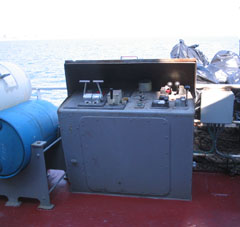 |
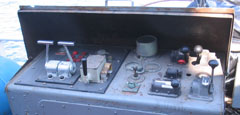
A complete
set of tug controls on the left and winch
controls on the right.
|
|
This is the after steering
station. The captain can steer the tug from
here and the console shares the winch controls.
Sometimes, this console is in a protected booth
called the dog house.
|
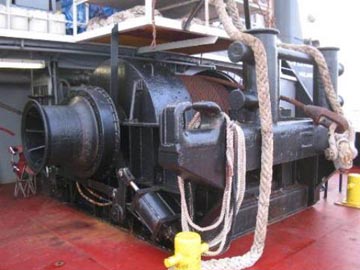 |
The towing winch has
one or two drums of cable. Here is the
capstan side of the winch. Most winches have
a capstan built on and controlled by the winch
station. If not, there is one nearby to haul
up the towing gear and get it on deck where the
crew can work with it.
|
|
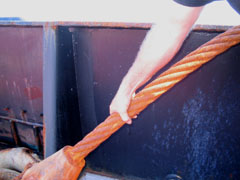
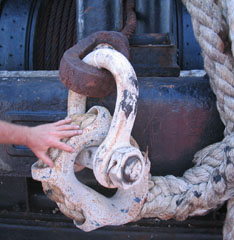
The cable
is very large. The average diameter of a cable
used in towing on most tugs is greater than 2
inches. |
Here is the thimble
end of the cable that will be attached to the
towing gear using large shackles.
|
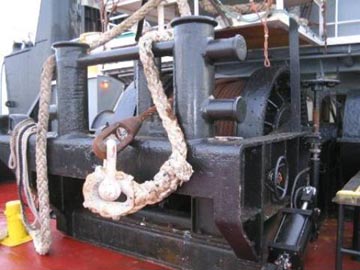 |
After the tow is
connected, the towing gear and a bit of cable are
sent back over the side for the ride out the open
water where the cable will be strung out.
A great concern to the
crew of a wire boat is the care of the towing wire.
Miles of towing across rough seas can chafe the
cable to a point where it will have to be replaced.
This is extremely expensive. There are
two common ways to relieve the wear stress on a
large cable.
|
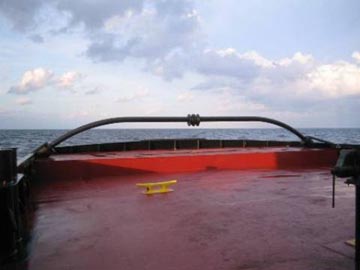 |
Depending on where the boat is from, this is a
Texas bar or a Dutch bar. The two wheels in
the middle there are called doughnuts and they can
slide separately the entire length of the bar.
A doughnut is slid down to the extreme end and the
captain steers the boat so that the stern runs
under the cable, which is by now hanging over the
side. As the cable tries to slide across the
stern rail, it falls into the doughnut and is
trapped.
|
Now the
cable and the doughnut will continue together to the
middle of the bar. The crew pass a small chain
around the doughnut and cable to keep the cable from
jumping out. On long trips, the cable is paid
out a few feet every so often to keep the same place
from riding in the doughnut for too long.
|
Here
is another example of gear to hold the cable in
place. These rollers on the stern of this
tug are able to be retracted. With one
roller up, the cable is steered into the center of
the stern as described before and then the second
roller is raised up to hold the cable to the
middle of the stern rail an on the horizontal
roller seen between the two roller there.
|
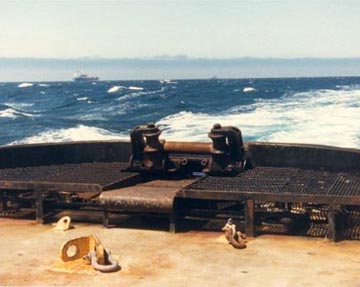 |
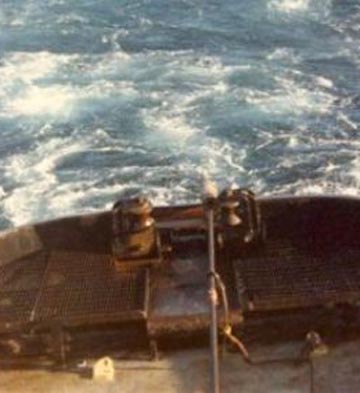 |
Here is a shot of the cable in place between the
rollers. You'll notice a piece of pipe has
been used for chafing gear. This kind of
gear is made by cutting a section, length-wise
out of a two or three foot long pipe. The
slot allows the cable to slip into the pipe.
Cable clips like this one have been welded to
the inside of the pipe, attached by the curve of
the u-bolt (top of image). The u-bolt is secure
with the two threaded ends ready to accept
the cable. The saddle (bottom of image) is
fastened down and the device clamps tight around
the cable.
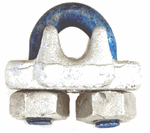
|
|
The resulting rig is a
piece of sturdy pipe that surrounds the cable and
prevents it from ever coming into contact with the
stern rail. |
Here is another shot of a towing cable over the
stern with no roller system. The chafing
gear can be seen more clearly and a hogging line
has been added to hold the cable more firmly in
place.
|
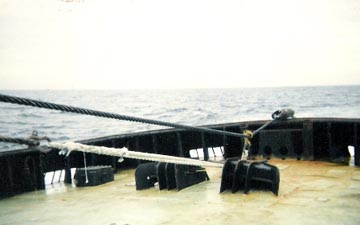
|
|
Much more can be written
on this subject but this should give you an idea of
how the tugs use cables during ocean towing. |
|
|
|
|
|